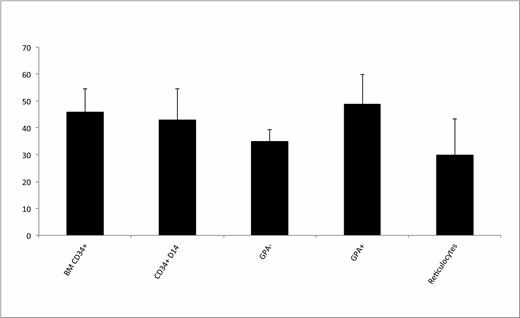Abstract

Refractory anemia with ring sideroblasts (RARS) is characterized by severe anemia, erythroid apoptosis and aberrant mitochondrial ferritin accumulation in erythroblasts. Dominant mutations in SF3B1, a core component of the splicing machinery are detected in more than 75% of patients. Of the recurrent mutations, SF3B1 alone is associated with the RARS phenotype. We recently showed that SF3B1 suppresses the expression of the mitochondrial transporter protein ABCB7, which in turn mediates erythroid failure in RARS. The exact mechanisms remain unclear, hence potential targets for treatment have not been identified. Fifty-six patients with RARS or RCMD-RS were subjected to targeted sequencing of which 52 (93%) had SF3B1 mutations and 43 also other recurrent mutations mostly involving epigenetic regulators. To explore the mechanisms behind the disrupted RARS erythropoiesis molecular and biological features of erythroid progenitors from SF3B1 mutated RARS and normal bone marrow (NBM) were monitored in vitro throughout a well-established 14-days liquid culture system. Normal and RARS transcriptomes (RNAseq) were analyzed at two time points (CD34+ cells at day 0 and early erythroblasts at day 4) during differentiation, followed by validation in an extended cohort of 11 RARS and 4 NBM using Taqman Low Density Array (TLDA). CD34+ RARS progenitors were characterized by activation of genes involved in the oxidative stress pathway and in particular genes involved in defense against oxidative stress, such as SEPP-1. This activation dropped dramatically at day 4. By contrast, early differentiation in RARS displayed a marked failure to up-regulate genes in the autophagy pathway, which is essential for removal of organelles and terminal maturation to erythrocytes.
In summary, we show that genes involved in autophagy are markedly down-regulated during early erythroid differentiation in RARS. While SF3B1 mutations do not confer a growth disadvantage to differentiating erythroid bone marrow progenitors, the final step of erythroid maturation to reticulocytes is clearly affected. Hence, we demonstrate a novel interference of the SF3B1 mutation with terminal erythroid maturation.
No relevant conflicts of interest to declare.
Author notes
Asterisk with author names denotes non-ASH members.

This icon denotes a clinically relevant abstract


This feature is available to Subscribers Only
Sign In or Create an Account Close Modal